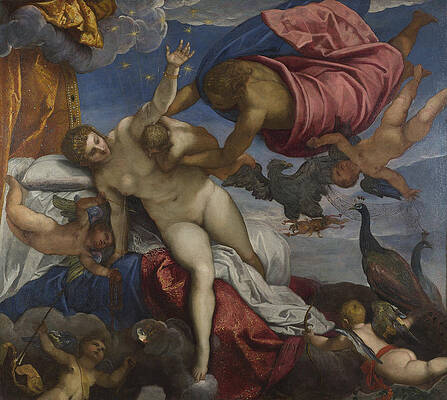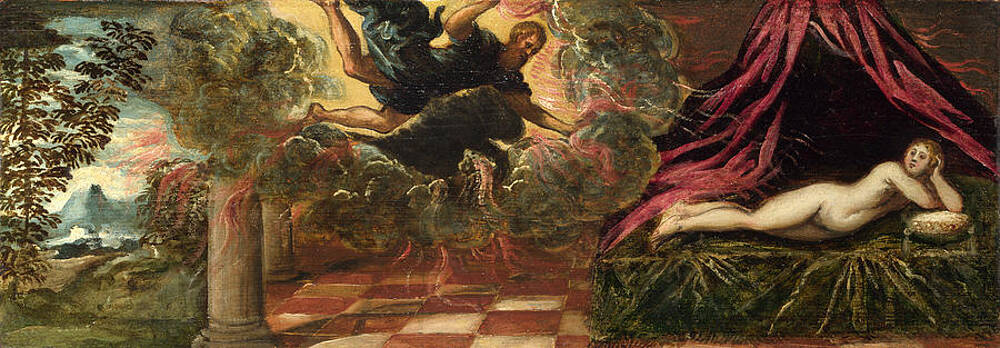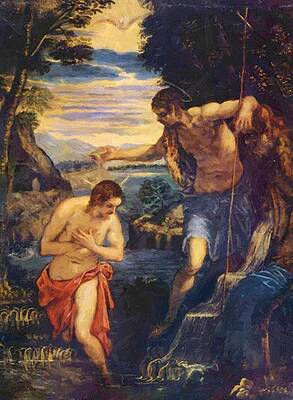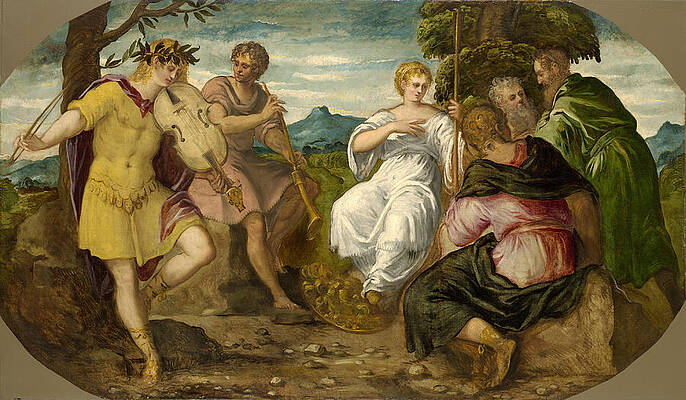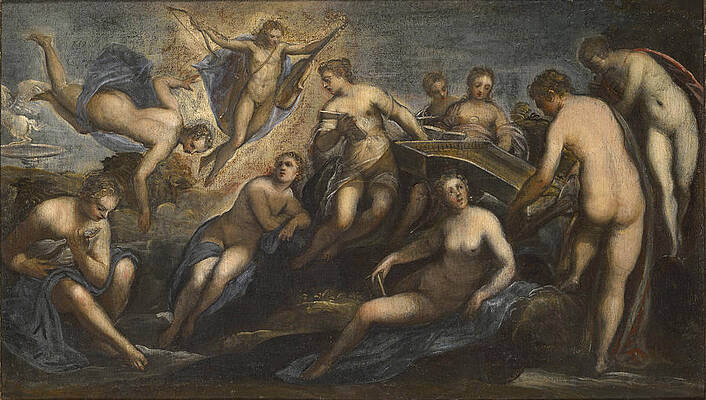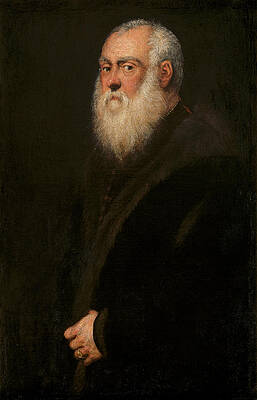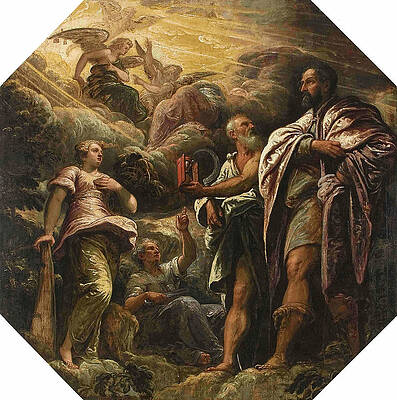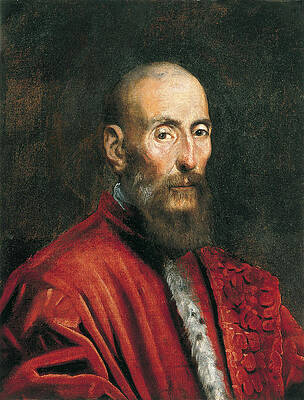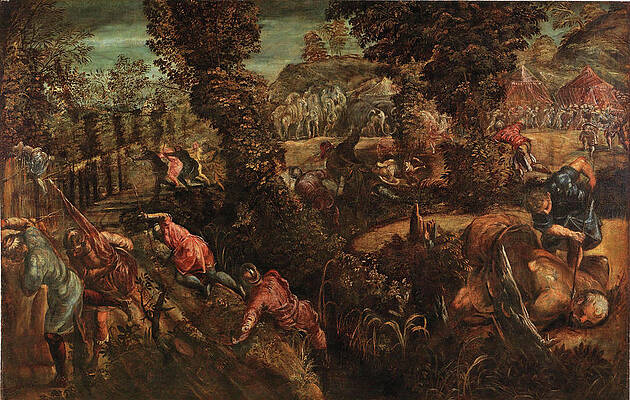Jacopo Tintoretto
Paintings
Portrait of a Woman Revealing Her Breasts
Christ Washing the Disciples Feet
Jupiter and Semele
Hercules Expelling the Faun from Omphale's Bed
Baptism of Christ
Allegory of Music
Annunciation to Manoahs Wife
Paradiso
Portrait of Vincenzo Morosini
Saint George and the Dragon
Doge Alvise Mocenigo Presented to the Redeemer
The Contest Between Apollo and Marsyas
The Supper at Emmaus
Doge Alvise Mocenigo and Family before the Madonna and Child
The Meeting of Tamar and Juda
The Madonna of the Stars
Old Man and a Boy
Portrait of a Man in a gold decorated suit of armour
Saint Jerome
Portrait of Senator Marco Grimani
Apollo with Concert of the Muses
Susanna and the Elders
Susanna
Muse with Lute
Judith and Holofernes
The Washing of the Feet
Angel from the Annunciation to the Virgin
The Queen of Sheba and Salomon
The Flagellation
Summer
The Worship of the Golden Calf
Portrait of a Senator
Man with a White Beard
Portrait of the Procurator Alessandro Gritti
The Rape of Helen
Saint Nicolas of Bari
Portrait of an Elderly bearded Man. Head and Shoulders
Allegory
Portrait of a Young Man as David
Portrait of a Senator
Lorenzo Soranzo
Twenty-five year old Youth with Fur-lined Coat
The Battle of Lepanto
The Battle between the Philistines and the Israelites

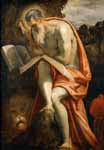

Portrait of an Elderly Man with a White Beard
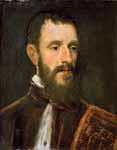
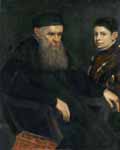

Portrait of Senator Marco Grimani
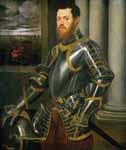
Portrait of a Man in a gold decorated suit of armour
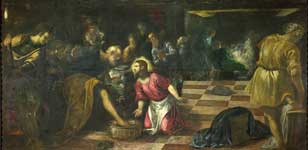
Christ Washing the Disciples' Feet


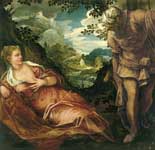
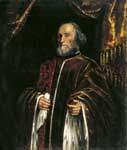
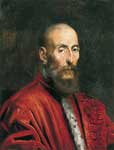
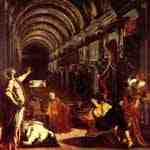
Discovery of the body of St. Mark


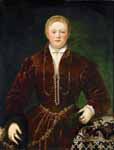
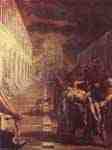
Salvage the corpse of St. Mark
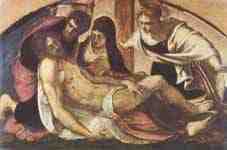


Christ at the Sea of Tiberias
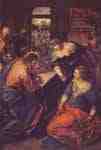
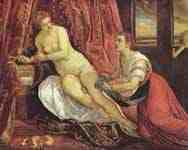

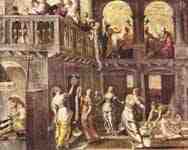
The Wise and the Foolish Virgins
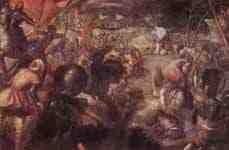
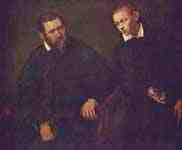
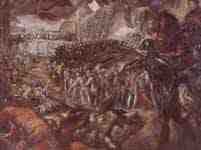
Frerico II Gonzaga conqueres Parma
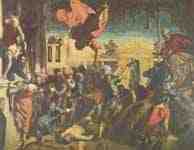
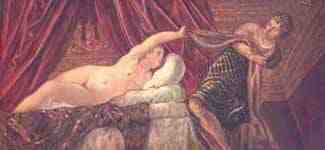
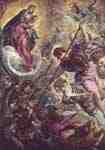
Archangel Michael fighting with Satan
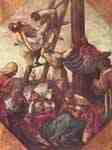
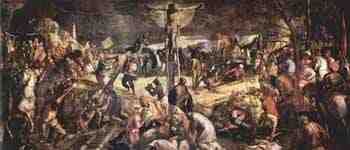

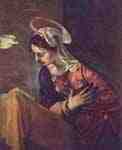
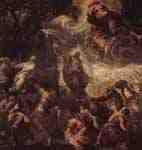
Moses Striking Water from the Rock
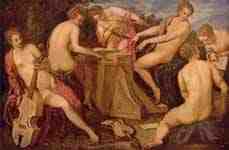
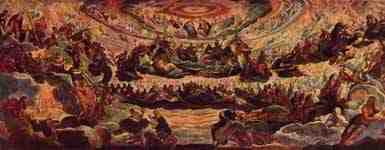
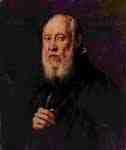
Portrait of the sculptor Jacopo Sansovino
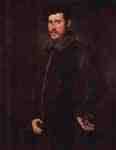
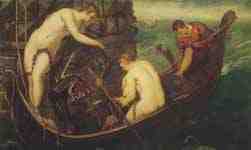

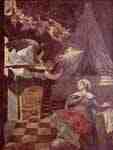

Venus and Mars surprised by Vulcan
Drawings
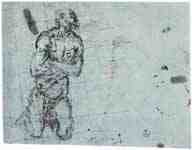



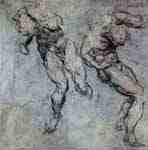
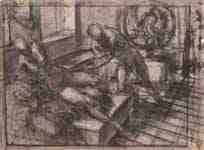
Tintoretto Italian pronunciation: [tintoˈretto] (born Jacopo Comin, late September or early October, 1518[1] – May 31, 1594), was an Italian painter and a notable exponent of the Renaissance school. For his phenomenal energy in painting he was termed Il Furioso. His work is characterized by its muscular figures, dramatic gestures, and bold use of perspective in the Mannerist style, while maintaining color and light typical of the Venetian School.[2]
In his youth, Tintoretto was also known as Jacopo Robusti as his father had defended the gates of Padua in a way that others called robust, against the imperial troops during the War of the League of Cambrai (1509–1516). His real name "Comin" has only recently been discovered by Miguel Falomir, the curator of the Museo del Prado, Madrid, and was made public on the occasion of the retrospective of Tintoretto at the Prado in 2007. Comin translates to the spice cumin in the local language.[3]
Life
The years of apprenticeship
Tintoretto was born in Venice in 1518, as the eldest of 21 children. His father, Giovanni, was a dyer, or tintore; hence the son got the nickname of Tintoretto, little dyer, or dyer's boy, which is anglicized as Tintoret. The family originated from Brescia, in Lombardy, then part of the Republic of Venice. Older studies gave the Tuscan town of Lucca as the origin of the family.
In childhood Jacopo, a born painter, began daubing on the dyer's walls; his father, noticing his bent, took him to the studio of Titian to see how far he could be trained as an artist. This was supposedly towards 1533, when Titian was already (according to the ordinary accounts) fifty-six years of age. Tintoretto had only been ten days in the studio when Titian sent him home once and for all, the reason being that the great master observed some very spirited drawings, which he learned to be the production of Tintoretto; and it is inferred that he became at once jealous of so promising a scholar. This, however, is mere conjecture; and perhaps it may be fairer to suppose that the drawings exhibited so much independence of manner that Titian judged that young Jacopo, although he might become a painter, would never be properly a pupil.
From this time forward the two always remained upon distant terms, Tintoretto being indeed a professed and ardent admirer of Titian, but never a friend, and Titian and his adherents turning the cold shoulder to him. Active disparagement also was not wanting, but it passed unnoticed by Tintoretto. The latter sought for no further teaching, but studied on his own account with laborious zeal; he lived poorly, collecting casts, bas-reliefs etc, and practising by their aid. His noble conception of art and his high personal ambition were evidenced in the inscription which he placed over his studio Il disegno di Michelangelo ed il colorito di Tiziano ("Michelangelo's design and Titian's color").[4]
He studied more especially from models of Michelangelo's Dawn, Noon, Twilight and Night, and became expert in modelling in wax and clay method (practised likewise by Titian) which afterwards stood him in good stead in working out the arrangement of his pictures. The models were sometimes taken from dead subjects dissected or studied in anatomy schools; some were draped, others nude, and Tintoretto was to suspend them in a wooden or cardboard box, with an aperture for a candle. Now and afterwards he very frequently worked by night as well as by day.
Early works
The young painter Andrea Schiavone, four years Tintoretto's junior, was much in his company. Tintoretto helped Schiavone gratis in wall-paintings; and in many subsequent instances he worked also for nothing, and thus succeeded in obtaining commissions.[5] The two earliest mural paintings of Tintoretto—done, like others, for next to no pay—are said to have been Belshazzar's Feast and a Cavalry Fight. These are both long since perished, as are all his frescoes, early or later. The first work of his to attract some considerable notice was a portrait-group of himself and his brother—the latter playing a guitar—with a nocturnal effect; this also is lost. It was followed by some historical subject, which Titian was candid enough to praise.
One of Tintoretto's early pictures still extant is in the church of the Carmine in Venice, the Presentation of Jesus in the Temple; also in S. Benedetto are the Annunciation and Christ with the Woman of Samaria. For the Scuola della Trinity (the scuole or schools of Venice were more in the nature of hospitals or charitable foundations than of educational institutions) he painted four subjects from Genesis. Two of these, now in the Venetian Academy, are Adam and Eve and the Death of Abel, both noble works of high mastery, which leave us in no doubt that Tintoretto was by this time a consummate painter - one of the few who have attained to the highest eminence in the absence of any formal training. Up till 2012, The Embarkation of St Helena in the Holy Land was attributed to his contemporary Andrea Schiavone. But new analysis of the work has revealed it as one of a series of three paintings by Tintoretto, depicting the legend of St Helena And The Holy Cross. The error was uncovered during work on a project to catalogue continental European oil paintings in the UK.[6] The Embarkation of St Helena was acquired by the V&A in 1865. Its sister paintings, The Discovery Of The True Cross and St Helen Testing The True Cross, are held in galleries in the US.[6]
Saint Mark paintings
Towards 1546 Tintoretto painted for the church of the Madonna dell'Orto three of his leading works - the Worship of the Golden Calf, the Presentation of the Virgin in the Temple, and the Last Judgment now shamefully repainted. He took the commission for two of the paintings, the Worship of the Golden Calf and the Last Judgment, on a cost only basis in order to make himself better known.[7] He settled down in a house hard by the church. It is a Gothic edifice, looking over the Fondamenta de Mori, which is still standing.[8] In 1548 he was commissioned for four pictures in the Scuola di S. Marco: the Finding of the body of St Mark, the St Mark's Body Brought to Venice, a St Mark Rescuing a Saracen from Shipwreck and the Miracle of the Slave. (these three are in Gallerie dell'Accademia Venice). The latter represents the legend of a Christian slave or captive who was to be tortured as a punishment for some acts of devotion to the evangelist, but was saved by the miraculous intervention of the latter, who shattered the bone-breaking and blinding implements which were about to be applied.[9]
St Mark's Body Brought to Venice (1548)
These four works were greeted with signal and general applause, including that of Titian's intimate, the too potent Pietro Aretino, with whom Tintoretto, one of the few men who scorned to curry favor with him, was mostly in disrepute. It is said, however, that Tintoretto at one time painted a ceiling in Pietro's house; at another time, being invited to do his portrait, he attended, and at once proceeded to take his sitter's measure with a pistol (or a stiletto), as a significant hint that he was not exactly the man to be trifled with. The painter having now executed the four works in the Scuola di S. Marco, his straits and obscure endurances were over.
In 1550, Tintoretto married Faustina de Vescovi (or Episcopi ?), daughter of a Venetian nobleman who was the guardian grande of the Scuola Grande di San Marco. She appears to have been a careful housewife, and one who both would and could have her way with her not too tractable husband. Faustina bore him several children, probably two sons and five daughters. The mother of Jacopo's daughter Marietta Robusti, a portrait painter herself, was probably a German woman, who had an affair with Jacopo before his marriage to Faustina.
Scuola di San Rocco
Between 1565 and 1567, and again from 1575 to 1588, Tintoretto produced a large number of paintings for the walls and ceilings of the Scuola Grande di San Rocco. The building, begun in 1525, was very deficient in light and thus ill-suited for any great scheme of pictorial adornment. The painting of its interior was commenced in 1560.
In that year five principal painters, including Tintoretto and Paolo Veronese, were invited to send in trial-designs for the centre-piece in the smaller hall named Sala dell'Albergo, the subject being S. Rocco received into Heaven. Tintoretto produced not a sketch but a picture, and got it inserted into its oval. The competitors remonstrated, not unnaturally; but the artist, who knew how to play his own game, made a free gift of the picture to the saint, and, as a bylaw of the foundation prohibited the rejection of any gift, it was retained in situ, Tintoretto furnishing gratis the other decorations of the same ceiling.
Detail of Portrait of a Venetian admiral (1570s, National Museum in Warsaw) where the original undercoat shines through, bears all the features of the newly developed technique with light and gentle brush despite "roughter" way of painting.[10]
In 1565 he resumed work at the scuola, painting the magnificent Crucifixion, for which a sum of 250 ducats was paid. In 1576 he presented gratis another centre-piece—that for the ceiling of the great hall, representing the Plague of Serpents; and in the following year he completed this ceiling with pictures of the Paschal Feast and Moses striking the Rock accepting whatever pittance the confraternity chose to pay.
The development of fast painting techniques called prestezza allowed him to produce many works while engaged on large projects and to respond to growing demands from the clients.[11]
Tintoretto next launched out into the painting of the entire scuola and of the adjacent church of San Rocco. He offered in November 1577 to execute the works at the rate of 100 ducats per annum, three pictures being due in each year. This proposal was accepted and was punctually fulfilled, the painter's death alone preventing the execution of some of the ceiling-subjects. The whole sum paid for the scuola throughout was 2447 ducats. Disregarding some minor performances, the scuola and church contain fifty-two memorable paintings, which may be described as vast suggestive sketches, with the mastery, but not the deliberate precision, of finished pictures, and adapted for being looked at in a dusky half-light. Adam and Eve, the Visitation, the Adoration of the Magi, the Massacre of the Innocents, the Agony in the Garden, Christ before Pilate, Christ carrying His Cross, and (this alone having been marred by restoration) the Assumption of the Virgin are leading examples in the scuola; in the church, Christ curing the Paralytic.
It was probably in 1560, the year in which he began working in the Scuola di S. Rocco, that Tintoretto commenced his numerous paintings in the Doge's Palace; he then executed there a portrait of the doge, Girolamo Priuli. Other works (destroyed by a fire in the palace in 1577) succeeded—the Excommunication of Frederick Barbarossa by Pope Alexander III and the Victory of Lepanto.
The Deliverance of Arsenoe (c. 1560)
After the fire, Tintoretto started afresh, Paolo Veronese being his colleague. In the Sala dell Anticollegio, Tintoretto painted four masterpieces - Bacchus, with Ariadne crowned by Venus, the Three Graces and Mercury, Minerva discarding Mars, and the Forge of Vulcan which were painted for fifty ducats each, besides materials, ca. 1578; in the hail of the senate, Venice, Queen of the Sea (1581–84); in the hall of the college, the Espousal of St Catherine to Jesus (1581–84); in the Antichiesetta, St George and St Nicholas, with St Margaret (the female figure is sometimes termed the princess whom St George rescued from the dragon), and St Jerome and St Andrew; in the hall of the great council, nine large compositions, chiefly battle-pieces (1581–84); in the Sala dello Scrutinio the Capture of Zara from the Hungarians in 1346 amid a Hurricane of Missiles (1584–87).
Paradise
The crowning production of Tintoretto's life, the last picture of any considerable importance which he executed, was the vast Paradise, in size 22.6 x 9.1 metres (74 ft. by 30 ft), reputed to be the largest painting ever done upon canvas. A painted sketch (143 x 362 cm), held in the Louvre Museum (Paris), was submitted as a proposal by Tintoretto for a picture in the Doge's Palace. It is a work so stupendous in scale, so colossal in the sweep of its power, so reckless of ordinary standards of conception or method, so pure an inspiration of a soul burning with passionate visual imagining and a hand magical to work in shape and colour, that it has defied the connoisseurship of three centuries, and has generally (though not with its first Venetian contemporaries) passed for an eccentric failure; while to a few eyes it seems to be so transcendent a monument of human faculty applied to the art pictorial as not to be viewed without awe.
While the commission for this huge work was yet pending and unassigned Tintoretto was wont to tell the senators that he had prayed to God that he might be commissioned for it, so that paradise itself might perchance be his recompense after death. Upon eventually receiving the commission in 1588 he set up his canvas in the Scuola della Misericordia and worked indefatigably at the task, making many alterations and doing various heads and costumes direct from nature.
When the picture had been nearly completed he took it to its proper place and there finished it, assisted by his son Domenico for details of drapery, etc. All Venice applauded the superb achievement, which has since suffered from neglect, but little from restoration. Tintoretto was asked to name his own price, but this he left to the authorities. They tendered a handsome amount; he is said to have abated something from it, an incident perhaps more telling of his lack of greed than earlier cases where he worked for nothing at all.
Death and pupils
After the completion of the Paradise Tintoretto rested for a while, and he never undertook any other work of importance, though there is no reason to suppose that his energies were exhausted had his days been a little prolonged.
In 1592 he became a member of the Scuola dei Mercanti.
In 1594, he was seized with severe stomach pains, complicated with fever, that prevented him from sleeping and almost from eating for a fortnight. He died on May 31, 1594. He was buried in the church of the Madonna dell'Orto by the side of his favorite daughter Marietta, who had died in 1590 at the age of thirty. Tradition suggests that as she lay in her final repose, her heart-stricken father had painted her final portrait.
Marietta had herself been a portrait-painter of considerable skill, as well as a musician, vocalist and instrumentalist, but few of her works are now traceable. It is said that up to the age of fifteen she used to accompany and assist her father at his work, dressed as a boy. Eventually, she married a jeweler, Mario Augusta. In 1866 the grave of the Vescovi and Tintoretto was opened, and the remains of nine members of the joint families were found in it. The grave was then moved to a new location, to the right of the choir.
Tintoretto had very few pupils; his two sons and Martin de Vos of Antwerp were among them. His son Domenico Tintoretto frequently assisted his father in the groundwork of great pictures. He himself painted a multitude of works, many of them of a very large scale. At best, they would be considered mediocre and, coming from the son of Tintoretto, are exasperating. In any event, he must be regarded as a considerable pictorial practitioner in his way. There are reflections of Tintoretto to be found in the Greek painter of the Spanish Renaissance El Greco, who likely saw his works during a stay in Venice.
Style of life and assessment
Tintoretto scarcely ever travelled out of Venice.[12] He loved all the arts and as a youth played the lute and various instruments, some of them of his own invention, and designed theatrical costumes and properties. He was also versed in mechanics and mechanical devices. While being a very agreeable companion, for the sake of his work he lived in a mostly retired fashion, and even when not painting was wont to remain in his working room surrounded by casts. Here he hardly admitted any, even intimate friends, and he kept his mode of work secret, with the exception of his assistants. He abounded in pleasant witty sayings, whether to great personages or to others, but he himself seldom smiled.
The Last Supper (1594)
Out of doors, his wife made him wear the robe of a Venetian citizen; if it rained she tried to induce him with an outer garment which he resisted. When he left the house, she would also wrap money up for him in a handkerchief, expecting a strict accounting on his return. Tintoretto's customary reply was that he had spent it on alms to the poor or to prisoners.
An agreement is extant showing a plan to finish two historical paintings, each containing twenty figures, seven being portraits in a two-month period of time. The number of his portraits is enormous; their merit is unequaled, but the really fine ones cannot be surpassed. Sebastiano del Piombo remarked that Tintoretto could paint in two days as much as himself in two years; Annibale Carracci that Tintoretto was in many pictures equal to Titian, in others inferior to Tintoretto. This was the general opinion of the Venetians, who said that he had three pencils—one of gold, the second of silver and the third of iron.
A comparison of Tintoretto's final The Last Supper with Leonardo da Vinci's treatment of the same subject provides an instructive demonstration of how artistic styles evolved over the course of the Renaissance. Leonardo's is all classical repose. The disciples radiate away from Christ in almost-mathematical symmetry. In the hands of Tintoretto, the same event becomes dramatic, as the human figures are joined by angels. A servant is foregrounded, perhaps in reference to the Gospel of John 13:14-16. In the restless dynamism of his composition, his dramatic use of light, and his emphatic perspective effects, Tintoretto seems a baroque artist ahead of his time.
In 2013, the Victoria and Albert Museum announced that the painting The Embarkation of St Helena in the Holy Land was painted by Tintoretto (and not by his contemporary Andrea Schiavone, as previously thought) as part of a series of three paintings depicting the legend of St Helena And The Holy Cross.[6]
Notes
Tintoretto and De Vecchi 1970, p. 83.
Zuffi, Stefano (2004). One Thousand Years of Painting. Milan, Italy: Electa. p. 427.
Spanish curator uncovers true name of Tintoretto[dead link]
Nichols, Tom. Tintoretto. Tradition and Identity. Redaktion Books, 1999, p. 14.
Nichols, Tom. Tintoretto. Tradition and Identity. Redaktion Books, 1999, p. 103 and 241ff.
"BBC News - Tintoretto painting uncovered at London V&A museum". Bbc.co.uk. 2013-06-07. Retrieved 2014-01-21.
Sortais, Gaston (1912). "Il Tintoretto". Catholic Encyclopedia 14. New York: Robert Appleton Company.
Nichols, Tom. Tintoretto. Tradition and Identity. Redaktion Books, 1999, p. 101.
"wga". Wga.hu. Retrieved 2014-01-21.
Grażyna Bastek. "Admirał młodzieńcem podszyty". Ośrodek Kultury Europejskiej EUROPEUM. Retrieved 20 June 2013.
Jamie Anderson, Jörg Reckhenrich, Martin Kupp (2011). "Prestezza - A New Way to Paint". The Fine Art of Success: How Learning Great Art Can Create Great Business. John Wiley & Sons. ISBN 11-19992-53-2.
Nichols, Tom. Tintoretto. Tradition and Identity. Redaktion Books, 1999, p. 13.
References
Butterfield, Andrew (2007-04-26). "Brush with Genius". New York Review of Books (NYREV, Inc.) 54 (7). Retrieved 2007-04-18.
Carlo Ridolfi, La Vita di Giacopo Robusti (A Life of Tintoretto) 1642
Tintoretto, and Pierluigi De Vecchi. 1970. L'opera completa del Tintoretto. Milano: Rizzoli. OCLC 399268 (Italian language)
Rossetti, William Michael (1911). "Tintoretto, Jacopo Robusti". In Chisholm, Hugh. Encyclopædia Britannica 26 (11th ed.). Cambridge University Press.
----
Fine Art Prints | Greeting Cards | Phone Cases | Lifestyle | Face Masks | Men's , Women' Apparel | Home Decor | jigsaw puzzles | Notebooks | Tapestries | ...
----
Artist
A - B - C - D - E - F - G - H - I - J - K - L - M -
N - O - P - Q - R - S - T - U - V - W - X - Y - Z
Retrieved from "http://en.wikipedia.org/"
All text is available under the terms of the GNU Free Documentation License


